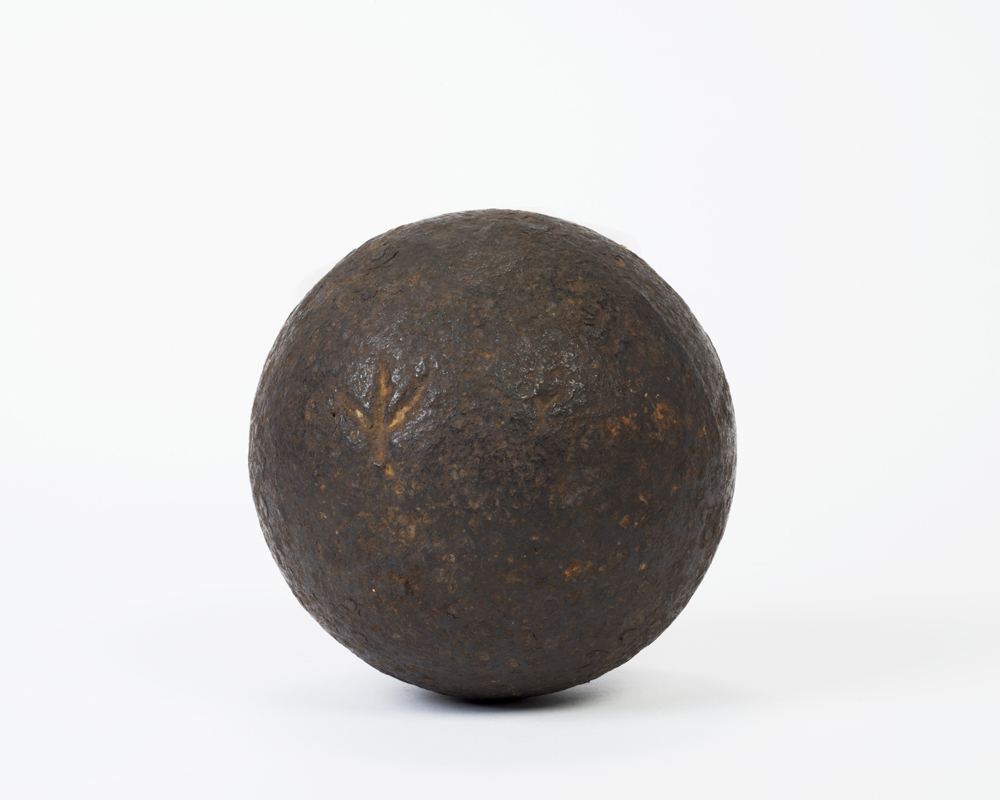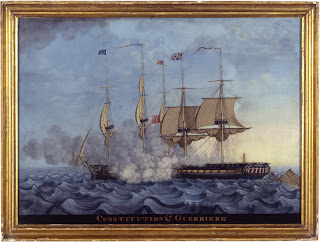Once in a while, a preponderance of evidence causes us to clarify a cherished story. In this case, we have to admit that “Old Ironsides” was not as impenetrable to enemy cannonballs as the popular histories make out.
A number of period sources mention enemy shot piercing Constitution’s hull. According to Abel Bowen, in his 1816 work The Naval Monument, during the battle with HMS Cyane and Levant, a British “shot came through the side of Constitution, killed one and wounded four men, and lodged in the galley…. In the action of the Guerriere the Constitution was hulled three times; in that of the Java four times, and in [the Cyane and Levant] engagement thirteen times….” The verb “to hull” refers unequivocally to passage of a cannonball through the side of a ship. This word was used time and again during the period to refer to damage sustained in battle. Bowen’s work is full of effusive praise for the American Navy, so his decision to include this detail is interesting. Of course, he also says “Naval History has a charm on the attention of the ardent, from being peculiarly the record of enthusiasm.” Perhaps his history has entirely too much enthusiasm.


The most famous reference to British balls rebounding (or not) from the ship’s hull comes from the pen of Seaman Moses Smith. In 1846, he published a short narrative of his time in the Navy called Naval Scenes in the Last War, or, Three Years on Board the Frigate Constitution and the Adams. While describing the beginning of the action with Guerriere, Smith wrote, an “18lb. shot came through us under the larboard knight-head, striking just abaft the breech of the gun to which I belonged” Smith’s station was the number one gun on the gundeck. The meaning of the term knighthead was in flux during this period. Sometimes it referred to the timbers used to secure the end of the bowsprit at the stem. The older usage made them synonymous with the foretopsail sheet bits, located just forward of the foremast on the spar deck; either way the timbers extended down to the gundeck below. If a shot came in “under” the knighthead, it had to have entered the hull on the gundeck. Did it come in through an open gunport? Apparently not, for Smith remembered that, “splinters flew in all directions; but no one was hurt.” Later, as the ships slugged it out, “Several shot now entered our hull.” And then, the famous lines: “One of the largest the enemy could command struck us, but the plank was so hard it fell out and sank in the waters. This was afterwards noticed [he never says how long afterwards-Author], and the cry arose: ‘Huzza! Her sides are made of iron! See where the shot fell out!’” So even here, in the middle of the action that gave the ship its enduring nickname, a number of shot crashed through the hull.


Isaac Mayo, a midshipman on board the Hornet, saw the battle damage done to Constitution by the Java off the coast of Brazil and recorded it in his journal: “came up with the Constitution…, and passed under her stern, one of the Midshipman from the prize ship John, had been just on board of me, we both discov[ere]d. that the Constitution had shot holes in her stern and stern boat.” These holes were probably the result of the raking fire poured into the ship by Java as the British crossed the Americans’ stern early in the engagement.
Despite the damage inflicted in battle, Constitution still carried most of it crew safely through the worst of the fight. The British crews always suffered considerably more casualties, and as the victories mounted so must the fame of the American frigate grown. By the end of 1813, the affectionate nickname given to Constitution by her sailors had begun to enter the popular lexicon. When Midshipman Pardon Mawney Whipple joined Constitution’s crew in May 1813, he referred to the ship as “…Old Ironsides; a name which has been given her by the sailors, supposing that her sides are impenetrable from the circumstances of very few [emphasis added] shot having as yet penetrated her side.” By the following year, the name appeared in the newspapers.
So, what conclusion can we draw from all this? Clearly, some British cannonballs passed through Constitution’s triple-layered hull. Some shot may have bounced off, but not all. Far from deflating a cherished myth, this knowledge should only strengthen Constitution’s reputation. Surely it would be no accomplishment for an invincible ship to defeat its enemies. On the other hand, if Constitution could still wrest victory from foes capable of doing considerable damage to its thick oaken sides, doesn’t that make the ship’s accomplishments all the more meaningful?
The Author(s)
Matthew Brenckle
Research Historian, USS Constitution Museum
Matthew Brenckle was the Research Historian at the USS Constitution Museum from 2006 to 2016.